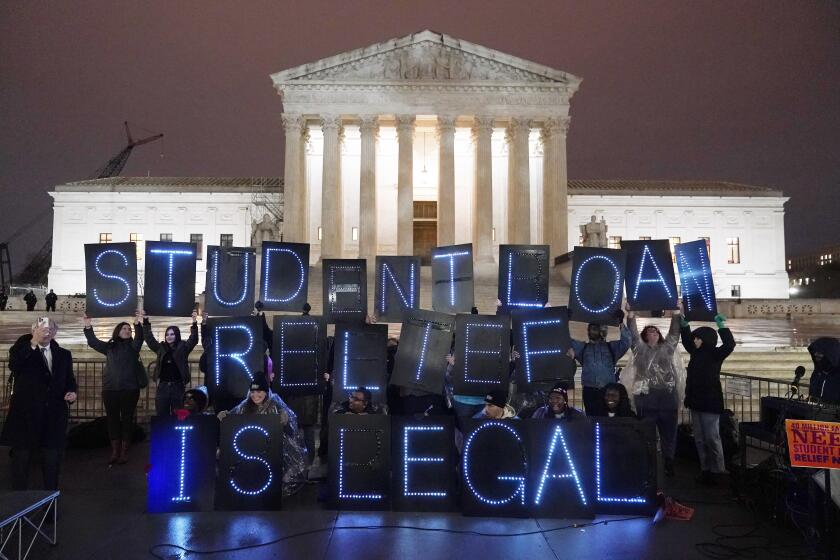School Funding Rules Challenged
A coalition of legal activists filed a lawsuit Thursday alleging that the rules California uses to distribute money for school construction are unfair to large urban districts with fast-growing enrollments and severely crowded campuses.
State regulations reward districts that file applications first. As a result, districts with the greatest need receive only a small fraction of the money, according to the lawsuit.
The state Constitution and the legislation behind the $9.1-billion state school bond passed by voters in 1998 require the money to be distributed based on need, the suit alleged.
“They confuse first-come, first-served with some kind of merit when all it does is favor the districts that are already favored,” said civil rights attorney Constance Rice, whose law firm was one of three that filed the case on behalf of dozens of students who attend year-round schools. Joining Rice’s firm were the Mexican American Legal Defense and Educational Fund and the Asian Pacific American Legal Center.
Urban districts can’t compete because of the difficulty in acquiring school-sized parcels in built-up areas, Rice said. To file an application, a district must own the land for a new school and have an architectural plan approved by the state architect.
The suit seeks an order to freeze all allocations for new public schools from the 1998 bond and to require state officials to come up with a new funding scheme that would reserve a large portion of the money for the most crowded districts, even if they have not sent applications to the state.
The impetus for the lawsuit comes from the 711,000-student Los Angeles Unified School District, which has been able to prepare applications for only a handful of the 150 new schools it needs to accommodate tens of thousands of new students expected to enroll in the coming years.
District officials say that if the schools aren’t built, there won’t be room for one more high school student in 2007, even if every high school goes year-round.
Because of its severe overcrowding, L.A. Unified meets the eligibility criteria for $1 billion, or more than a third of the money available. But because it has been so slow to prepare applications, the district currently is in line for only about $25 million before the money runs out.
Rice said the lawsuit would also benefit the other 34 districts that have had students on multitrack calendars for at least a decade because of severe facilities shortages.
“This is not just about L.A. Unified,” Rice said. “This is about the state and an unconstitutional allocation system.”
The lawsuit alleges that a statewide pattern exists in which “a disproportionate number of new schools have been built in districts with a higher average income and a lower percentage of minority students.”
Examining the board’s allocation of $3 billion from past bonds, the attorneys said they found that none had gone to several growing districts, including San Diego Unified, San Jose Unified and Garden Grove Unified.
An exhibit filed with the lawsuit indicated that the Twain Harte-Long Barn Union Elementary School District in Tuolumne County had received more than $5 million in new school construction funds since 1989, while its enrollment grew from 752 to 756. In contrast, the La Habra City Elementary School District in Orange County grew 32% to more than 7,000 students, but received only about $1 million in funds.
The lawsuit also cited three districts--Capistrano, Clovis and Antioch--that had grown by more than 40% in enrollment since 1989 without having to convert any schools to year-round schedules. All had white majorities and low poverty rates, it said.
Over the same period, the percentage of L.A. Unified students in year-round schools has climbed from 25% to 45%, the suit said.
The lawsuit names as defendants Gov. Gray Davis, State Supt. of Instruction Delaine Eastin, the Office of Public School Construction and the State Allocation Board, the panel that approves applications for school bond funds.
State officials contested the claim.
“Our opinion is that the system that is there is fair and works,” said Sandy Harrison, spokesman for the state Department of Finance, which holds one seat on the State Allocation Board. “Schools who apply and show a need do get their funding for their buildings.”
In a written opinion on the claims, a lawyer for the department concluded that the regulations for apportioning school construction money conform with the law.
It would be unwise to interrupt the funding process, added Garry Ness, assistant chief counsel, because “other districts with critical housing needs having submitted projects waiting to be approved and funded would be harmed by the delay.”
During an initial hearing Thursday, Los Angeles Superior Court Judge David Jaffee declined to set a hearing date that would allow consideration of a preliminary injunction before the next meeting of the State Allocation Board on April 26. Jaffee said he thought the state needed more time to prepare.
Attorneys bringing the lawsuit still could seek a hearing in another court before then. However, Deputy Atty. Gen. Christopher C. Foley said he would ask for a continuance if they do.
More to Read
Sign up for Essential California
The most important California stories and recommendations in your inbox every morning.
You may occasionally receive promotional content from the Los Angeles Times.







